Letters from Lodi
An insightful and objective look at viticulture and winemaking from the Lodi
Appellation and the growers and vintners behind these crafts. Told from the
perspective of multi-award winning wine journalist, Randy Caparoso.
2022 update on Lodi's oldest vine growths (part 2)—east side of the Mokelumne River AVA
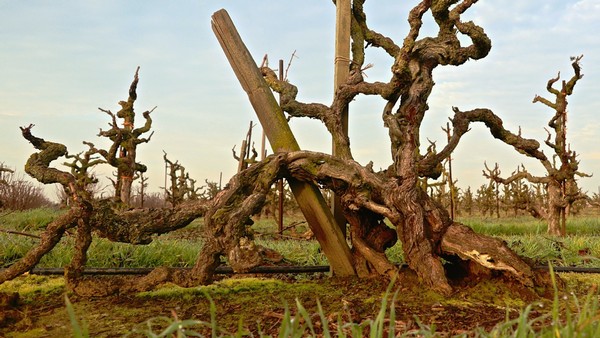
118-year-old Zinfandel in Lizzy James Vineyard, located in the heart of the east side of Lodi's Mokelumne River AVA.
Continued from our previous post: 2022 update on Lodi's oldest vine growths (part 1)—west side of the Mokelumne River AVA
Lodi old-timers have long known that when it comes to old vine Zinfandel, east is east and west is west, which makes neither one "best." Just different.
The acknowledged dividing line between east and west is the historic railroad track first laid down by Central Pacific Railroad in 1869, running north-south smack down the middle of the City of Lodi. The direction followed by the tracks roughly outlines slight differences in the soil series—officially identified as Tokay fine sandy loam since the 1990s—which also defines the parameters of Lodi's Mokelumne River AVA.
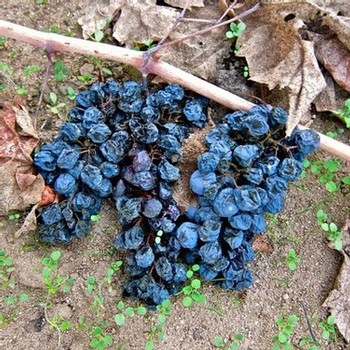
Dried, discarded Zinfandel clusters on Tokay sandy loam soil.
The soil-related differences are recognized in this way:
• The sandy loam soil on the west side of the Mokelumne River AVA is generally richer in loamy, organic content.
• There is more sand content in east side soils—particularly in a roughly triangular-shaped area in the vicinity of the town of Victor (called the "Victor Triangle" by a few local growers)—which increases drainage because of lower moisture-retaining capacity.
• There is also a deeper consistency of sandy loam on the east side, together with lower water tables.
The most direct impact of lower water tables and sandier soil on the east side is on the average cluster weight and berry size of grapes. Smaller berries and clusters mean higher skin-to-juice ratios, as well as earlier ripening, and both factors, can result in lower pH, higher total acidity, and increased phenolic content. Phenolic content derived from grape phenols and polyphenols affects the color, tannin as well as aromatic compounds of resulting wines.
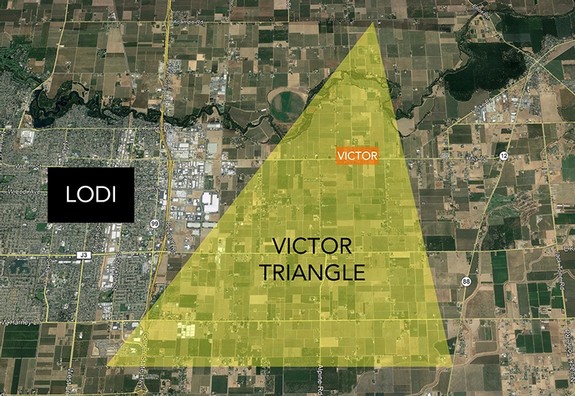
The parameters of the unofficial "Victor Triangle" on the east side of Lodi, where growers have always observed pockets of the deepest, sandiest soils in Mokelumne River appellation.
In plainer English, this means Zinfandels grown on Lodi's east side are generally zestier in acidity, and more fragrant and red fruit scented than Zinfandels grown on the west side. Zinfandel grown on the west side are generally fuller, broader, and rounder in feel, and replete with both red and dark fruit fragrances, as well as being earthier—with aromas tinged with loamy, occasionally mushroomy qualities—than east side Zinfandels.
Hence, the way in which we list Lodi's better-known old vine plantings is divided into these three categories:
1. West-side Mokelumne River AVA vineyards (for details, see our previous post-2022 update on Lodi's oldest vine growths, part 1)
2. East-side Mokelumne River AVA vineyards (the subject of this post)
3. East-side Clements Hills AVA vineyards (covered in part 3 of our 2022 update on Lodi's oldest vines)
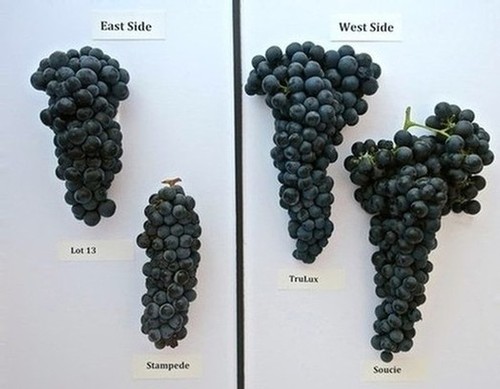
Graphic comparison of the impact of east vs. west side Mokelumne River-Lodi soils on Zinfandel cluster morphology.
Old vine growths on the east side of the Mokelumne River AVA
Lizzy James Vineyard, Zinfandel
Vineyard name: Lizzy James Vineyard
Year planted: 1904 and mid-1970s
Size: 8 hectares
Variety(ies): Zinfandel
Wineries: Harney Lane Winery
• This 20-acre vineyard located along Alpine Road, south of Highway 12 East and north of East Kettleman Lane, consists of head-trained Zinfandel dating back to 1904. The original vines are interplanted with more vigorous spur-pruned, vertical cordon vines planted mostly during the 1970s.
• Oldest vines were originally field grafted onto Black Prince (once categorized as Rose of Peru by the USDA), a Viti's vinifera cultivar more popular in the late 1800s and early 1900s.
• This block sits on possibly the single sandiest site in the entire Mokelumne River AVA, the closest thing to beach-like sands in Lodi. As such, it is the most “east-side” of Lodi’s east-side vineyards.
• Owned and farmed by Harney Lane Winery, Lizzy James produces a svelte, medium- to the full-bodied style of Zinfandel with ringing notes of cherry/raspberry, floral, and spiced tea scents, moderate tannin, and consistent balancing acidity.
• Registered by Historic Vineyard Society.
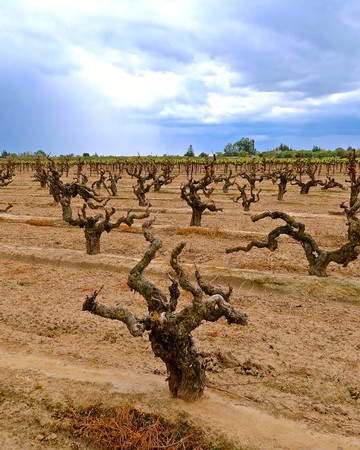
Century-old Zinfandel growing in ultra-sandy soil in Scottsdale Vineyard, located in the southwest corner of the "Victor Triangle."
Scottsdale Vineyard, Zinfandel
Vineyard name: Scottsdale Vineyard
Year planted: Early 1900s and 1960s
Size: 1 hectare
Variety(ies): Zinfandel
Wineries: Harney Lane Winery
• Scottsdale Vineyard is a 2.5-acre, own-rooted, head-trained Zinfandel block whose oldest vines date back to sometime in the early 1900s, with younger vines planted in the 1960s. In recent years it was farmed by Mettler & Son, the farming arm of Harney Lane Winery, and in 2013 it was purchased by Harney Lane Winery.
• The vineyard is located at the far western edge of the east side of the Mokelumne River AVA, along Scottsdale Road, between the railroad tracks east of West Lane and Highway 99. The vines grow in ultra-sandy soil yielding a notably small (palm-sized) cluster morphology typifying other east-side Lodi Zinfandel growths.
• Harney Lane co-owner/grower Kyle Lerner has always described Scottsdale as the “blueberry block” because of the floral, blue, and red berry-scented quality of resulting wines, similar to the fruit profile of Zinfandels grown in Rous Vineyard on Mokelumne River-Lodi's east side, south of Victor Road.
Kirschenmann Vineyard, Zinfandel
Vineyard name: Kirschenmann Vineyard
Year planted: 1915
Size: 7.7 hectares
Variety(ies): Zinfandel
Wineries: Turley Wine Cellars; Sandilands Wines; Bedrock Wine Co.; Arnot-Roberts; Precedent Wine; Carlisle Winery
• This 19-acre block of own-rooted, largely head-trained Zinfandel was originally planted in 1915 and was farmed by Alan Kirschenmann until he died in 2004.
• The vineyard was known as Baumbach Vineyard up until 2012 when it was purchased by Tegan Passalacqua of Turley Wine Cellars from Sandy Laskey (née Kirschenmann). It is now farmed for Passalacqua by Arbor Vineyards, the vineyard management company associated with Mettler Family Vineyards.
• It is located just east of Bruella Road, south of Schmiedt Road, inside an oxbow curve of the Mokelumne River, circumstances that are said to have a significant impact on both the temperatures—a degree or two cooler than surrounding areas—and unique soil—streaks of limestone and silica found in the deep loamy sand. Adjoining McCay Cellars’ Lot 13 and Klinker Brick Winery’s Rauser Vineyard, this unique terroir accounts for the unusual number of surviving ancient vine plantings found in the vicinity. These Zinfandel blocks typically include smatterings of Alicante Bouschet, Carignan, and Mondeuse Noire.
• Kirschenmann has become known for distinctively flowery, multifaceted fruit qualities—typically cherry, tea, and licorice/anise—and gentle, silken, layered styles of Zinfandels bottled by Turley Wine Cellars, Carlisle Winery, Arnot-Roberts, Bedrock Wine Co., Precedent Wine, and Passalacqua’s own Sandlands Wines label.
• Registered by Historic Vineyard Society.
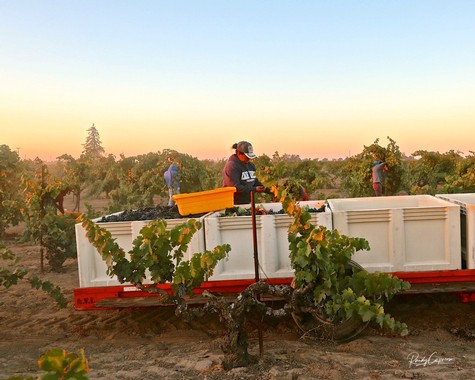
Zinfandel harvest of ancient vines growing in beach-like sandy soil in Kirschenmann Vineyard.
Rous Vineyard, Zinfandel
Vineyard name: Rous Vineyard
Year planted: Mid-1930s
Size: 4 hectares
Variety(ies): Zinfandel
Wineries: Ironstone Vineyards; McCay Cellars; Macchia Wines
• This 10-acre block was planted in 1909 on St. George rootstock (one of the oldest in Lodi grafted onto Rupestris du Lot St. George). It is owned and farmed by Craig Rous, former director of the Kautz family’s Bear Creek Winery, and Woodbridge by Robert Mondavi.
• The vineyard is located toward the center of the “Victor Triangle”—very close to Lewis Vineyard and Lizzy James Vineyard—a section characterized by a deeper, sandier (almost like beach sand) variation of Tokay Series fine sandy loam.
• It produces uniquely flowery (violet/blueberry) styles of Zinfandel with herby nuances and full, fleshy, rounded structures under the Ironstone Vineyards, Macchia Wines, and McCay Cellars labels.
Lot 13 Vineyard, Zinfandel, and Tempranillo
Vineyard name: Lot 13 Vineyard (a.k.a. Faith Vineyard)
Year planted: 1918 and mid-1990s
Size: 5.2 hectares
Variety(ies): Zinfandel; Tempranillo
Wineries: McCay Cellars
• This vineyard consists of 10 acres of own-rooted, largely head-trained, spur-pruned Zinfandel that was originally planted in 1918 on a patch of exceptionally sandy loam with limestone and silica layers at Schmiedt and Brucella roads, a stone's throw away from the Mokelumne River.
• The property was acquired by Michael McCay in 2013 from the Kirschenmann family and named for the original lot number (13) found on a 1906 Colonial Green Tract plat map.
• The vineyard is located in an oxbow-bend of the Mokelumne River where vineyards are surrounded by water on three sides and thus, dubbed “The Peninsula” by McCay. It lies near the north corner of the “Victor Triangle” and is separated by a dirt road from Kirschenmann Vineyard to the west and a tractor lane from Dairy Vineyard to the east.
• The Zinfandel is bottled by McCay Cellars as Faith and is also used in most of McCay’s bottlings of Lodi Native Zinfandel. In 2017, 2018, and 2019, a good amount of Lot 13 Zinfandel was picked for Ridge Vineyards for use in blends.
• In the mid-1990s 3 acres of the old vine Zinfandel were removed and replanted with trellised Tempranillo—as such, the first block of Tempranillo to be planted in the Lodi appellation—the fruit from which is bottled as vineyard-designate varietals by McCay Cellars, Fields Family Wines and m2 Wines.
• Registered by Historic Vineyard Society.
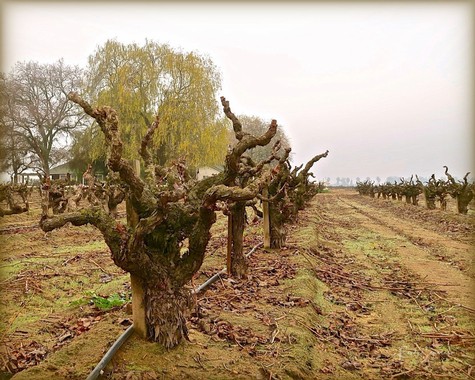
Small vine Zinfandel architecture in the 300-acre Peirano Estate.
Peirano Estate Vineyards, Zinfandel
Vineyard name: Peirano Estate
Year planted: Late 1890s
Size: 32.4 hectares
Variety(ies): Zinfandel
Wineries: Peirano Estate
• Peirano Estate is one of the largest blocks of own-rooted, head-trained Zinfandel in Lodi.
• The original vines were planted by Giacomo Peirano, who immigrated from Genoa in Italy, in the late 1890s, and continue to be owned and farmed by Peirano's great-grandson Lance Randolph, who bottles the Zinfandel under his Peirano Estate "The Immortal Zin" label.
• The Peirano Estate Zinfandel can be depended upon for a moderately weighted, zesty, rounded, fragrant red fruit and black tea-scented style typical of Mokelumne River AVA Zinfandels grown in deeper, sandier soils.
• Randolph has retained the "small vine" (just 2- to 3 feet high), the goblet-style architecture of Peirano's original planting. In fact, he has planted the rest of the 300-acre Peirano Estate in the same fashion (Cabernet Sauvignon, Chardonnay, Sauvignon blanc, Merlot, Tempranillo, Petite Sirah, Syrah, Malbec, and Muscat Canelli, all on small, head-trained vines).
Rauser Vineyard, Carignan
Vineyard name: Rauser Vineyard
Year planted: 1909
Size: 4 hectares
Variety(ies): Carignan; Alicante Bouschet; Zinfandel
Wineries: Klinker Brick Winery
• This Bruella Road vineyard is owned by Jeannie Rauser and is now managed by the Felten family of Klinker Brick Winery.
• Rauser's vineyard consists of mostly own-rooted, spur-pruned, ancient vine Carignan planted in 1909, with a mix of equally old Alicante Bouschet and Zinfandel interplanted with recent Carignan replants.
• It is located in the heart of the Mokelumne River AVA’s east side, inside the “Victor Triangle,” right across Schmidt Road from Tegan Passalacqua’s Kirschenmann Vineyard and kitty-corner to McCay Cellars’ Lot 13 Vineyard.
• Most of the vineyard goes into Klinker Brick’s Carignane bottling (medium-bodied, black cherry-scented reds with scrubby/earthy undertones), although a small portion of the fruit is picked earlier in the season, at lower sugars and higher natural fruit acidity, to go into dry rosés bottled by Klinker Brick.
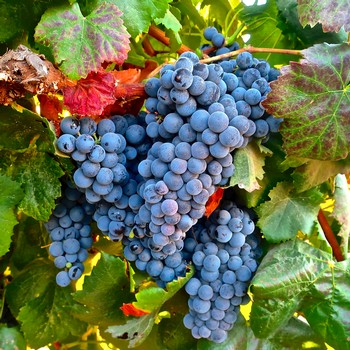
Alicante Bouschet in Rauser Vineyard.
Charlie Lewis Vineyard, Zinfandel
Vineyard name: Charlie Lewis Vineyard
Year planted: 1903
Size: 3.3 hectares
Variety(ies): Zinfandel
Wineries: LangeTwins Family Winery & Vineyards
• This own-rooted, thick-trunked, goblet-trained, ancient vine Zinfandel block was planted in 1903 about 50 yards west of Alpine Road, near Victor Road/Highway 12 East. It sits on a patch of particularly fine sandy loam that extends south into nearby Lizzy James Vineyard and west toward Rous Vineyard.
• It is owned and farmed according to LODI RULES for Sustainable Winegrowing by Charlie Lewis, with all fruit going entirely to LangeTwins Family Winery & Vineyards.
• LangeTwins Family’s vineyard-designate Lewis Vineyard Zinfandel is typically meatily textured with red fruit, red licorice, and black tea-scented fragrances, and a svelte, zippy, moderately weighted feel despite alcohol tipping into the 15% range.
Marisa Vineyard, Zinfandel
Vineyard name: Marisa Vineyard
Year planted: 1928
Size: 6.5 hectares
Variety(ies): Zinfandel
Wineries: Klinker Brick Winery
• This classic loamy sand/east-side site, located just east of the town of Victor on Highway 12 East, is owned and farmed by the Felten family of Klinker Brick Winery.
• The vineyard, originally planted in 1928, is a 50/50 split of own-rooted and Flame Tokay-rooted vines, the latter half grafted over to Zinfandel in the late 1980s.
• It produces consistently refined, gentle, silky styles of Zinfandels, the opposite of “big” or bludgeoning, with distinctively floral raspberry/cassis-like perfumes.
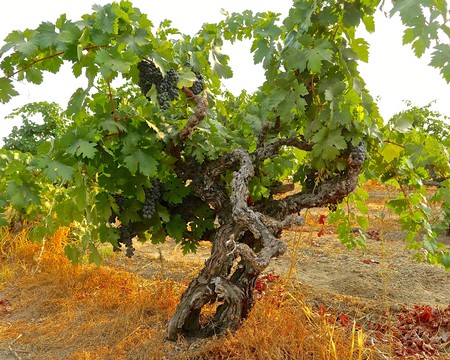
Zinfandel was originally planted in 1907 on St. George rootstock in Turley Wine Cellars' Steacy Ranch.
Steacy Ranch, Zinfandel
Vineyard name: Steacy Ranch Vineyard
Year planted: 1907, the 1950s and 1960s
Size: 16.2 hectares
Variety(ies): Zinfandel
Wineries: Turley Wine Cellars; Neyers Vineyards; Mettler Family Vineyards
• This 40-acre block is owned and farmed by Turley Wine Cellars and located on the north side of Acampo Road, just east of North Kennifick Road.
• The oldest vines (about 21% of the vineyard) were planted in 1907. As such, they are the oldest Lodi Zinfandel vines of record planted on St. George rootstock, as opposed to the natural Zinfandel roots typifying the vast majority of pre-1960s Lodi Zinfandel growths.
• Only the fruit from the oldest vines goes into Turley's vineyard-designate bottling, Steacy Ranch Zinfandel.
• Most of the vineyard consists of Zinfandel plantings—also on St. George—dating back to the 1950s and ‘60s. It is also interspersed with Grenache, Carignan, and Mission vines. Fruit from 50- to 60-year-old vines goes into Turley's Old Vines blend, plus a small amount goes into the winery's dry-style Zinfandel Rosé. Most recently, some of this fruit has been going to Neyers Vineyards; while the vineyard's most recent replants, which are less than 25 years old, go into Turley's Juvenile program.
• The oldest vines produce zesty yet notably silken, fine-textured, vineyard-designate Zinfandels of moderate weight and "feminine" structuring, with flowery red fruit perfumes tinged with spice (pepper, thyme, allspice, etc.).
• In recent years, Neyers Vineyards and Mettler Family Vineyards have been producing Zinfandels from the east side of the vineyard, from vines planted during the 1950s.
Noma Ranch, Zinfandel
Vineyard name: Noma Ranch
Year planted: Early 1900s
Size: 2.5 hectares
Variety(ies): Zinfandel
Wineries: Bedrock Wine Co.
• These own-rooted, spur-pruned Zinfandel vines now comprise less than half of the original 15-acre plot in existence up until 2016. It was planted during the first decade of the 1900s south of Victor Road/Highway 12 East, across East Pine Street from Lodi Memorial Park & Cemetery.
• The vines are unusually small for Lodi, just 2 to 3 feet high. The site was dry farmed for over a century and vines are trained in the classic goblet style, yielding largely fist-sized, tiny-berried clusters rarely adding up to more than 1.5 tons per acre.
The vines were farmed for many years by Leland Noma, but are now tended by Mettler Family's Arbor Vineyards. Until recently the fruit was bottled exclusively by Macchia Wines under their Outrageous label, but now goes to Bedrock Wine Company in Sonoma.
• Noma Ranch traditionally produces a big—almost always close to 16% alcohol—concentrated style of Zinfandel with unusually high acid/tannin balance resulting from extreme skin-to-juice ratios and tiny cluster weights.
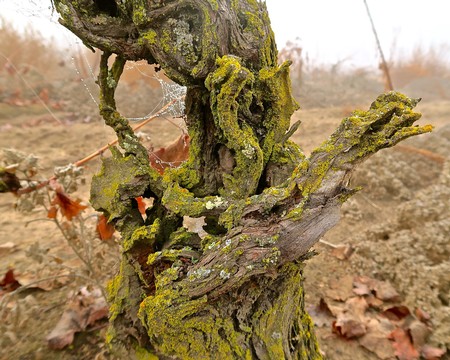
Lichen-crusted wood of small vines In Noma Ranch, dry farmed on Lodi's east side for over 100 years
Dairy Vineyard (Schmiedt Ranch), Zinfandel
Vineyard name: Dairy Vineyard (a.k.a., Schmiedt Ranch)
Year planted: 1918
Size: 3.2 hectares
Variety(ies): Zinfandel
Wineries: Twisted Roots Wine; Turley Wine Cellars
• This own-rooted, head-trained, spur-pruned Zinfandel was planted by the Schmiedt family in 1918 along the banks of the Mokelumne River where it is diverted north and bent into an oxbow, just east of Bruella Road, at the end of Schmiedt Road. The Schmiedt family still owns and farms this vineyard.
• The soil shares the common factor of exceptionally sandy, limestone-streaked alluvium with adjacent vineyards, notably Mike McCay’s Lot 13 Vineyard just to the west and Tegan Passalacqua’s Kirschenmann Vineyard another block over. The dairy produces styles of Zinfandel similar to Lot 13 and Kirschenmann—flowery, red cherry perfumes and zesty, moderate weights, and tannins.
• Most of Dairy Vineyard’s fruit has been going to Turley Wine Cellars, although each year some of it is bottled under the Schmiedt family’s Twisted Roots 1918 label.
Schmiedt’s 1902, Zinfandel
Vineyard name: Schmiedt's 1902
Year planted: 1902
Size: 1.6 hectares
Variety(ies): Zinfandel
Wineries: Michael Kouda Wines
• This postage-stamp-sized, 4-acre block consists of head-trained, own-rooted Zinfandel planted in 1902 on the Schmiedt family property between Bruella Road and Cherry Road (south of Schmiedt Road). It lies in the center of the east side’s “Victor Triangle,” defined by exceptionally fine, powdery, deep loamy sand.
• It is farmed by fourth-generation grower Galen Schmiedt, son of Carl Schmiedt and nephew of Ross and Leland Schmiedt.
• The fruit is now bottled as a vineyard-designate wine by Michael Klouda Wines in a contemporary, early-picked, terroir-focused style.
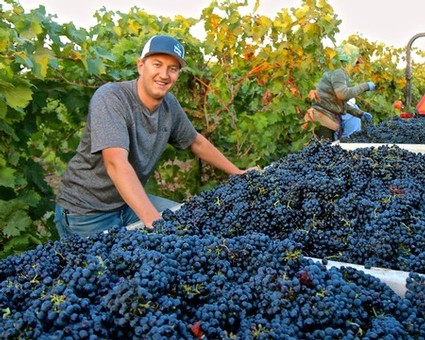
Cemetery Vineyard owner/grower with his Zinfandel harvest.
Cemetery Vineyard, Zinfandel
Vineyard name: Cemetery Vineyard
Year planted: Early 1980s
Size: 2.8 hectares
Variety(ies): Zinfandel
Wineries: Macchia Wines; m2 Wines; Oak Farm Vineyards
• This vertical cordon-trained vineyard was planted on high-vigor Freedom rootstock ([solonis x Othello] x Dogridge) in the early 1980s.
• The site, located across the road from Cherokee Memorial Park & Funeral Home (hence the "Cemetery" moniker), sits on a pocket of extremely porous, deep, sandy soil, at the western edge of the sub-area of the Mokelumne River AVA unofficially called the Victor Triangle.
• The vineyard is owned and managed by Aaron Shinn, general manager of Round Valley Ranches. Fruit formerly went into Woodbridge by Robert Mondavi Winery's White Zinfandel program. In recent years, Shinn has been farming it for lower yields, with grapes going into the Zinfandel programs of local wineries such as Macchia, m2, and Oak Farm Vineyards.
• A past native yeast fermented, vineyard-designate bottling by Oak Farm called "Indigenous" has demonstrated a moderately weighted, bright, zesty, finely textured varietal profile with red cherry/blueberry perfumes, not unlike Zinfandels from other Victor Triangle vineyards.
Somers Vineyard, Mission
Vineyard name: Somers Vineyard
Year planted: Late 1970s
Size: 7.3 hectares
Variety(ies): Mission
Wineries: Sabelli-Frisch; Monte Rio Cellars; Voluptuary + Lucid Wines; Toogood Winery; Buena Vista Winery
• This 18-acre vineyard is devoted entirely to Mission (a.k.a., Criolla or Pais) and was planted on a low-lying flat right alongside the Mokelumne River. Consequently, the site's Tokay sandy loam soil is extremely vigorous, and vine roots have easy access to a high water table (in wetter winters, the vineyard is flooded for weeks at a time when the riverbank overflows). The result is highly productive, free-standing, spur-pruned vertical cordon vines topping 6 feet in height.
• Vineyard has been farmed by Mike Agnagnos of Sunwest Ag Service since 2007, who has managed to market these grapes (largely unwanted until recently) to several small, handcraft style wineries exploring the recent popularity of pale colored, low phenolic styles of red wine, for which the Mission grape is known.
• Although Mission, a notorious late ripener (typically October), is known for low acidity, table reds made from Somers Vineyard tend to retain good natural acidity because of the site's high vigor, yielding as much as 5 tons per acre (in dryer years, less than half that), resulting in fruit that is slow to color and develop sugar content, especially when shaded by the dense canopy typically grown by these oversized vines.
• Part of the vineyard also goes to solera style sweet dessert wines—California's traditional (generic) name for fortified wines made from Mission is Angelica—maintained by wineries such as Toogood in El Dorado and Buena Vista in Sonoma Valley.
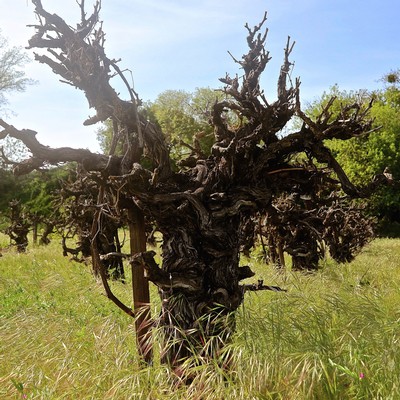
Tall, massive Mission vine in Somers Vineyard, along the banks of the Mokelumne River on the east side of Lodi.
Fathom Vineyard, Zinfandel
Vineyard name: Fathom Vineyard
Year planted: 1924 and 1990
Size: 8 hectares
Variety(ies): Zinfandel
Wineries: Mettler Family Vineyards; Neyers Vineyards; Hahn Family Wines
• 20 acres of this block, located on an extremely sandy site of the Mokelumne River AVA, consists of head-trained, own-rooted Zinfandel originally planted by the Horst family in 1924.
• 16 acres of this block consist of taller, vertical cordon-trained Zinfandel planted in 1990.
• The vineyard was purchased in 2015 by Jason Eells, the vineyard manager of Mettler Family Vineyards, who lives on the adjoining property. Eells farm it by LODI RULES for Sustainable Winegrowing.
• Mettler Family Vineyards has begun producing vineyard-designate bottlings of this growth in a low-input style to emphasize the sense of place.
Katushas' Vineyard, Zinfandel
Vineyard name: Katushas' Vineyard
Year planted: 1915
Size: 4 hectares
Variety(ies): Zinfandel; Carignan; Flame Tokay
Wineries: Bedrock Wine Co.
• This small block of predominantly own-rooted Zinfandel, sitting just east of Rauser Vineyard and across Schmiedt Rd. from Kirschenmann Vineyard, was purchased by Bedrock Wine Co.'s Morgan Twain-Peterson in 2014.
• The vineyard is registered by the Historic Vineyard Society and is sustainably farmed.
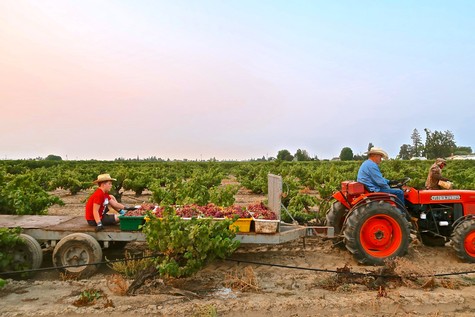
The Holman family's Flame Tokay harvest in the Historic Vineyard Society-recognized Old School Vineyard.
Old School Vineyard, Flame Tokay
Vineyard name: Old School Vineyard
Year planted: 1906
Size: 1.3 hectares
Variety(ies): Flame Tokay
Wineries: Delta Artisan
• 3 acres of head-trained, own-rooted Flame Tokay (a.k.a., Tokay) planted in 1906; during the heyday of this historic cultivar grown primarily as a table grape and responsible for the original wealth of the City of Lodi (incorporated in 1906)
• Vineyard is currently owned by Cheryl Holman and has been in her family since 1991.
• Grapes once contracted to E. & J. Gallo (up until 2000), and now goes to a Lodi-based company producing a Tokay Brandy.
• Registered by Historic Vineyard Society.
Look for our next post: 2022 update on Lodi's oldest vine growths (part 3)—the Clements Hills AVA
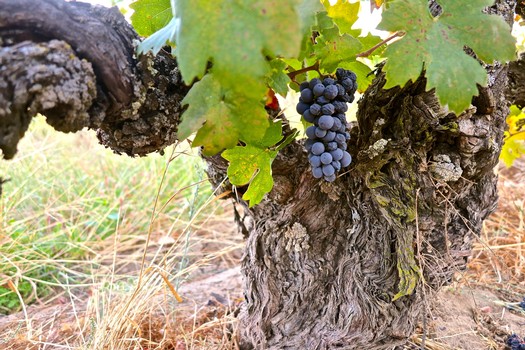
Unpicked Zinfandel in October in Fathom Vineyard, planted in the 1920s.